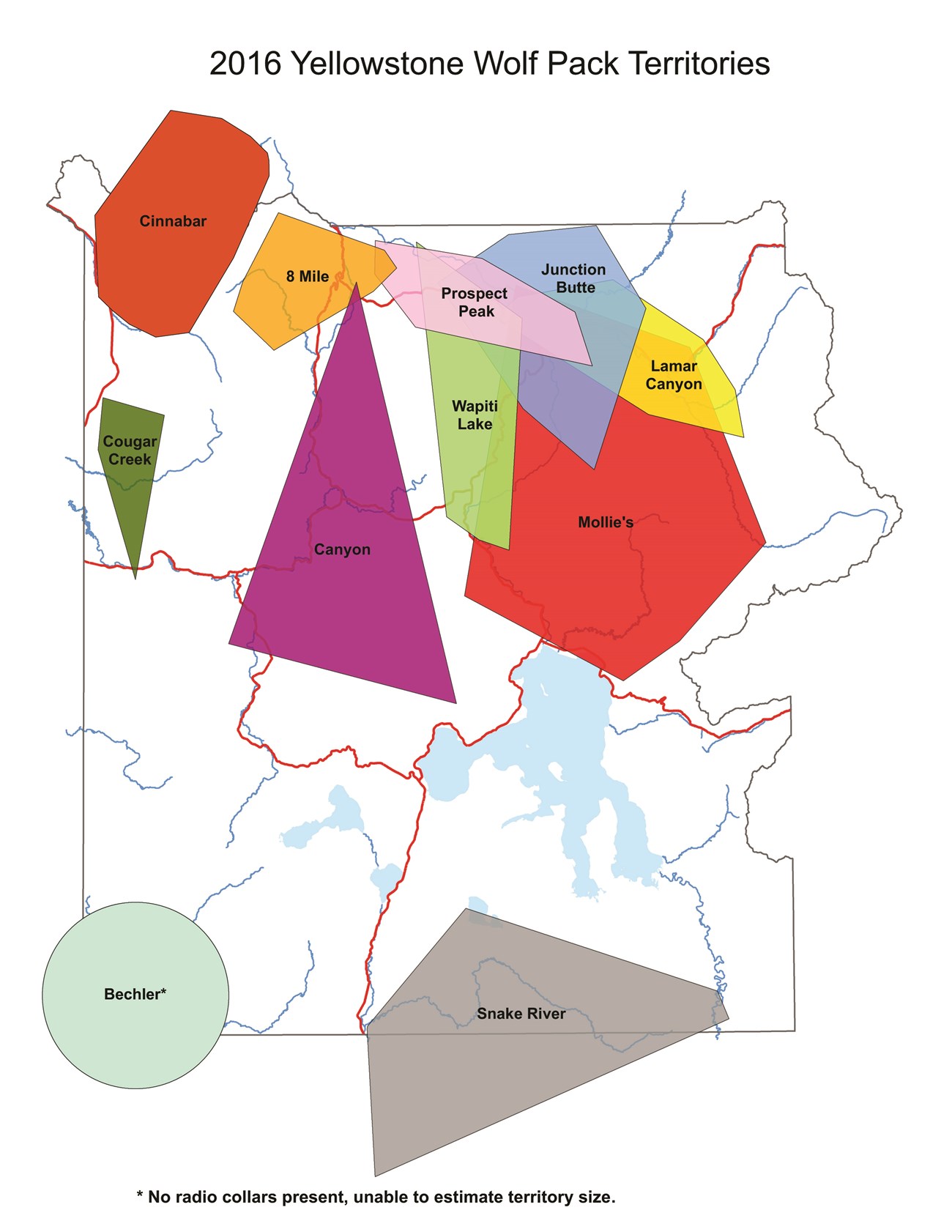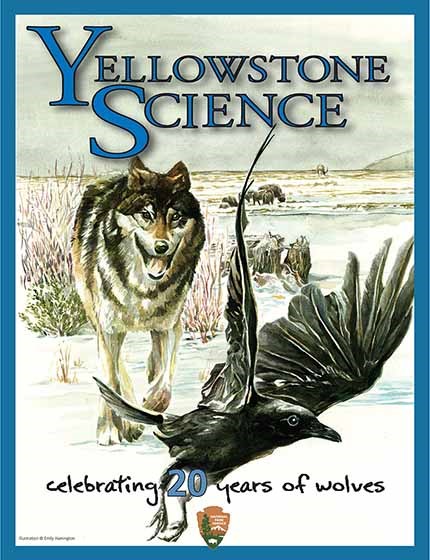Last updated: August 1, 2017
Article
Yellowstone Wolf Project Report 2016

Summary
There were at least 108 wolves in 11 packs (7 breeding pairs) living primarily in Yellowstone National Park (YNP) through December 2016 (figures 1& 2). Breeding pairs are defined as an adult male and an adult female with two pups that survive through the end of the year. Overall, wolf numbers have fluctuated between 83-108 wolves and 6-9 breeding pairs from 2009 to 2016. Pack size in 2016 ranged from 3 to 18 (table 1), averaging 9.8 in size. Park-wide, 36 pups survived to year end, 16 in northern Yellowstone and 20 in the interior of the park, with an average of 4.0 pups per pack surviving for 9 packs with confirmed reproduction.
Wolf-Prey Relationships
Project staff detected 235 kills that were definitely, probably, or possibly made by wolves in 2016: 161 elk (68.5%), 19 bison (8.1%), five mule deer (2.1%), 14 deer of unknown species (6% probably mule deer), four coyotes (1.7%), three wolves (1.3%), three pronghorn (1.3%), three bighorn sheep (1.3%), two badgers (0.9%), two snowshoe hares (0.9%), one moose (0.4%), one beaver (0.4%), and 17 unidentified animals (7.2%). The composition of elk kills was 36.0% calves, 5.6% yearlings, 21.1% adult females, 26.7% adult males, 2.5% adults of unknown sex, and 8.1% of unknown sex and age. Wolf predation was monitored intensively for five months of the year – one month in early winter (mid-November to mid-December), one month in late winter (March), and three months in spring-summer (May-July). The type of prey killed by wolves varies by time period and consists primarily of elk. However, predation on other prey such as bison may be changing with their increasing abundance (figure 3).
Winter Studies
During March 2016, our “late” winter study period, a total of 22 ungulate carcasses fed on by wolves were discovered by air and ground teams. Thirteen (59%) of these ungulates were killed by wolves, including 11 elk, one bison, and one deer. Four of the elk (36%) were calves, one (9%) was an adult female, and six (55%) were adult males. Wolves also fed on nine ungulates they did not kill, of which four were elk and five were bison.
During November-December 2016, our “early” winter study period, a total of 22 ungulate carcasses fed on by wolves were discovered by air and ground teams. Twenty (91%) of these ungulates were killed by wolves, which included 11 elk, three bison, two deer, and four unknown species. Four of the elk (36%) were calves, two (18%) were adult females, and five (45%) were adult males. The wolves also fed on two bison that they did not kill. In addition, the wolves also killed one snowshoe hare.
Summer Predation
Wolf predation was also assessed from May through July. This was achieved by hiking to clusters (a location other than a home site where a wolf spent 30 minutes or more) generated from satellite collars (e.g., GPS collars) to search for prey remains. Only some of the wolves in each pack wear GPS collars, and not all GPS collars are used to search for clusters. We found 81 suspected kills or fresh carcasses of ungulate prey, which included 54 (67%) elk, 12 (15%) bison, 9 (11%) deer, two (2%) bighorn sheep, two (2%) pronghorn, one (1%) horse (scavenged after a concessionaire left the animal in the park), and one (1%) unknown species. We also detected two badgers and one snowshoe hare.
Project staff detected 235 kills that were definitely, probably, or possibly made by wolves in 2016: 161 elk (68.5%), 19 bison (8.1%), five mule deer (2.1%), 14 deer of unknown species (6% probably mule deer), four coyotes (1.7%), three wolves (1.3%), three pronghorn (1.3%), three bighorn sheep (1.3%), two badgers (0.9%), two snowshoe hares (0.9%), one moose (0.4%), one beaver (0.4%), and 17 unidentified animals (7.2%). The composition of elk kills was 36.0% calves, 5.6% yearlings, 21.1% adult females, 26.7% adult males, 2.5% adults of unknown sex, and 8.1% of unknown sex and age. Wolf predation was monitored intensively for five months of the year – one month in early winter (mid-November to mid-December), one month in late winter (March), and three months in spring-summer (May-July). The type of prey killed by wolves varies by time period and consists primarily of elk. However, predation on other prey such as bison may be changing with their increasing abundance (figure 3).
Winter Studies
During March 2016, our “late” winter study period, a total of 22 ungulate carcasses fed on by wolves were discovered by air and ground teams. Thirteen (59%) of these ungulates were killed by wolves, including 11 elk, one bison, and one deer. Four of the elk (36%) were calves, one (9%) was an adult female, and six (55%) were adult males. Wolves also fed on nine ungulates they did not kill, of which four were elk and five were bison.
During November-December 2016, our “early” winter study period, a total of 22 ungulate carcasses fed on by wolves were discovered by air and ground teams. Twenty (91%) of these ungulates were killed by wolves, which included 11 elk, three bison, two deer, and four unknown species. Four of the elk (36%) were calves, two (18%) were adult females, and five (45%) were adult males. The wolves also fed on two bison that they did not kill. In addition, the wolves also killed one snowshoe hare.
Summer Predation
Wolf predation was also assessed from May through July. This was achieved by hiking to clusters (a location other than a home site where a wolf spent 30 minutes or more) generated from satellite collars (e.g., GPS collars) to search for prey remains. Only some of the wolves in each pack wear GPS collars, and not all GPS collars are used to search for clusters. We found 81 suspected kills or fresh carcasses of ungulate prey, which included 54 (67%) elk, 12 (15%) bison, 9 (11%) deer, two (2%) bighorn sheep, two (2%) pronghorn, one (1%) horse (scavenged after a concessionaire left the animal in the park), and one (1%) unknown species. We also detected two badgers and one snowshoe hare.






Five radio-collared wolves died in 2016 (table 2): two were killed by other wolves, one kicked and killed by an ungulate, one died of unknown natural causes (necropsy was delayed by river levels and exact cause of death could not be determined), and one was legally shot outside the park boundary. Ages of wolf mortalities varied, with two old adults (>6-years-old), one adult (2-5-years-old), one yearling, and one pup. In addition, staff recorded seven uncollared wolf deaths; one was natural (intraspecific), and six were harvested during the wolf hunting season in Montana.
Disease
There was no evidence of any major disease mortality. The Lamar Canyon pack began the year with varying levels of mange infection among individuals (some mild and some severe); but by the fall, the one male and two remaining females had recovered.
Pup Survival
Each year staff attempt to establish early pup counts at dens by either observing from the ground through spotting scopes or, more often, taking photos of the den area during tracking flights. Since wolf pups normally stay underground for their first three to five weeks, the earliest counts are often of two- to three-months-old pups. For some packs whose den sites are unknown or hidden, we do not get pup counts until the pups are moved to a rendezvous site in the early fall. This year we were able to get exceptionally early counts from the Junction Butte pack (first pup sighting was May 4 of a pup only ~15 days old) and tracked their survival throughout the entire year (figure 4).
Wolf Capture
Seven wolves in three packs were captured and collared in 2016 (table 3). In addition to marking them, a number of measurements and biological samples were taken. Two females and five males were captured; two were old adults (>6-years-old), one was an adult (2-5-years-old), one was a yearling, and three were pups (<12 months). Unfortunately, 62% of the new collars malfunctioned due to a manufacturing issue. We lost track of two packs because of this; thus, wolves with non-working radio collars are targeted for recollaring in 2017.
Wolf Management
Wolf management activities included den site closures. For the first time in several years, there were no reported hazing events on habituated wolves. Staff continued to manage wolf viewing areas in Slough Creek, Lamar Valley, Hayden Valley, and other areas where wolves were frequently observed. There was no wolf hunt in Wyoming because wolves were still protected under the Endangered Species Act. Idaho and Montana conducted wolf hunts. Six wolves from two packs (three Junction Butte and three 8 Mile) with territories primarily in YNP were legally harvested in Montana while outside the park boundary.

8 Mile (18 wolves; 8 adults, 10 pups)
At least two, and possibly three, litters were born to the 8 Mile pack in 2016 for a total of 12 pups. The pack continued to use their traditional territory, but in November they traveled outside the park and three pack members (one adult male and two pups) were shot during the Montana wolf hunting season. The remaining 18 pack members stayed together, led by long-time alpha female 909F, who turned 7-years-old in 2016.
Prospect Peak (11 wolves; 9 adults, 2 pups)
During the 2016 breeding season, a younger male (likely dispersed into the pack from 8 Mile in late 2014) started to dominate 10-year-old 763M, who remained with the pack as a subordinate until his disappearance in November. Alpha female 821F (turned 7-years-old) had a litter of four pups; two were still alive by the end of the year. Several subordinate wolves formed a splinter group during the fall and winter, but by December were mostly with the main group again. Observers recorded the Prospect Peak pack successfully hunting a female and calf bison in late November, a behavior rarely recorded on the Northern Range.
Junction Butte (7 wolves; 3 adults, 4 pups)
Alpha female 970F died of unknown natural causes only two weeks after her estimated whelp date, but two subordinate females denned in the Slough Creek area. They produced a total of nine pups, and the pack was the center of wolf watching activity this year. During the fall, three pack members (a yearling male, yearling female, and one pup) were shot outside the park, alpha male 911M was killed by the Prospect Peak pack, beta male 890M dispersed to the Mollie’s pack, and several yearlings and pups disappeared. From a summer high of 19 wolves, the pack ended the year with two adult females, one yearling female, and four pups.
Lamar Canyon (5 wolves; 5 adults, 0 pups)
Mange affected most members of the Lamar Canyon pack, likely playing a role in the deaths or disappearances of all three of 2015’s pups and one yearling by late February. Alpha female 926F may have localized near a den, but we never observed any pups; and within several weeks the pack did not return to the area. Three adult males (992M, 993M, and uncollared “Mottled”) died or disappeared, leaving only 965M and two females. In October, three males from the Beartooth pack in Wyoming traveled to Lamar Valley, and the two Lamar Canyon females stayed with them, causing 965M to disperse.
Mollie’s (18 wolves; 14 adults, 4 pups)
The Mollie’s pack began 2016 with no apparent alpha male, although alpha female 779F produced a litter of four pups. Three males dispersed to the Wapiti Lake pack over the summer. Perhaps with fewer adult males in the pack, Junction Butte beta male 890M was able to join the Mollie’s pack in late July. The Mollie’s pack spent late 2016 in their interior territory, perhaps taking advantage of winter-weakened bison.
Wapiti Lake (9 wolves; 5 adults, 4 pups)
The Wapiti Lake female produced a litter of four pups, and the pack was viewed nearly daily in Hayden Valley over the summer. In July, three males from the Mollie’s pack began to interact with the females and pups, leading 755M to avoid the area. Although he delivered food to his pups for several weeks during the transition, eventually 755M left and dispersed while the new pack of nine traveled together.
Canyon (6 wolves; 5 adults, 1 pup)
Tracking this pack relied on chance sightings and remote cameras. Still led by 10-year-old 712M and the 11-year-old white alpha female, the pack was seen with one gray pup in late summer. It is unknown if a younger female is the mother of the pup. The pack traveled in the Mammoth Hot Springs area near the end of the year, following elk movements to low elevation.
Cougar Creek (8 wolves; 6 adults, 2 pups)
Much of Cougar Creek pack territory was included in the massive, yet fragmented, Maple Creek fire during summer 2016. By fall we recorded at least two pups present. A later flight confirmed the pack has at least eight members.
Cinnabar (3 wolves; 3 adults)
In July, seven year-old subordinate male 910M from the 8 Mile pack joined other wolves, including sw5023F from the Cinnabar pack. They traveled partly in old Cinnabar pack territory and were given that pack name as a result.
Snake River (14 wolves; 9 adults, 5 pups)
The Snake River pack used their traditional den site and produced at least six pups, with five still alive in the fall. One radio-collar reached the end of battery life and dropped off in the spring; the other stopped working by the end of the year.
Bechler (9 wolves; 4 adults, 5 pups)
For the first time in Bechler territory, staff deployed two remote cameras on a game trail during the fall months. Cameras successfully captured images and videos of five adults (one a white wolf) with four pups. It is unknown where the Bechler pack travels during the winter, but this was the first reliable count in years.

Public outreach included giving 278 formal talks, participating in 82 interviews, helping 12,810 people view wolves, making 41,682 visitor contacts, and giving 772 informal talks in the field. Volunteers (table 4) worked over 13,000 hours in 2016. In April 2016, Wolf Project Research Associate Kira Cassidy gave a TEDx talk in Bozeman, MT, on the value of the oldest group members of social species, including wolves and humans. The talk titled “Aging in the wild: lessons from animals on the value of growing old” is on YouTube (https://www.youtube.com/watch?v=Y5M7e0PWFtk&t=10s).

To download a copy of
Yellowstone Science: Celebrating 20 Years of Wolves,
visit nps.gov/yellowstonescience
Tags
- yellowstone national park
- yellowstone wolf project
- ycr
- yellowstone center for resources
- yell-tr
- douglas w. smith
- dan stahler
- erin stahler
- matt metz
- kira cassidy
- brena cassidy
- lisa koitzsch
- quinn harrison
- elizabeth cato
- rick mcintyre
- yellowstone
- wolves
- wolf-prey relationships
- summer predation
- mortalities
- disease
- pup survival
- wolf capture
- wolf management
- outreach
- volunteers
